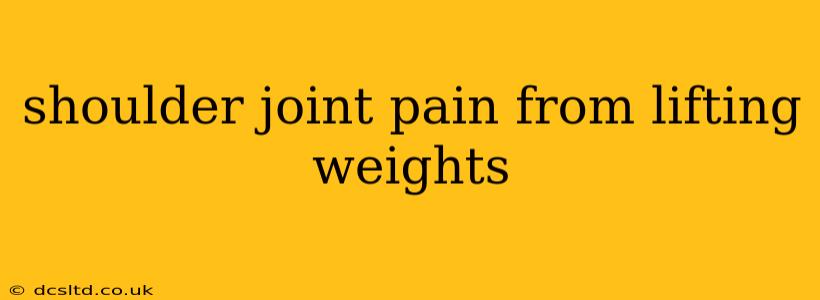Shoulder pain after weightlifting is a common complaint among fitness enthusiasts, ranging from mild discomfort to debilitating injury. Understanding the causes, prevention strategies, and treatment options is crucial for maintaining a healthy training regimen and avoiding long-term problems. This comprehensive guide explores the intricacies of weightlifting-related shoulder pain, offering practical advice and expert insights.
Common Causes of Shoulder Pain from Lifting Weights
Several factors can contribute to shoulder pain stemming from weight training. These range from improper form and overuse to underlying medical conditions.
-
Improper Lifting Technique: Incorrect form is a primary culprit. Lifting too much weight without proper stabilization, using jerky movements, or neglecting the warm-up phase can significantly strain the shoulder joint, leading to pain and injury. This often manifests as rotator cuff injuries, muscle strains, or tendonitis.
-
Overuse and Overtraining: Excessive training volume, intensity, or frequency without adequate rest can overload the shoulder muscles and tendons. This overuse leads to inflammation, micro-tears, and ultimately, pain. Failing to allow sufficient recovery time between workouts exacerbates this issue.
-
Muscle Imbalances: Weaknesses in supporting muscles, such as the rotator cuff muscles or scapular stabilizers, can increase stress on the shoulder joint. This imbalance makes the joint more susceptible to injury during lifting. For instance, weak rotator cuffs cannot adequately stabilize the shoulder during heavy lifts, leading to impingement.
-
Poor Warm-up: Inadequate warm-up routines fail to prepare the muscles and joints for the demands of weightlifting. Cold, inflexible muscles are more prone to injury. A thorough warm-up is essential to increase blood flow, improve range of motion, and prepare the body for exercise.
What are the Signs and Symptoms of Weightlifting-Related Shoulder Pain?
Recognizing the signs of shoulder pain is critical for timely intervention and preventing further damage. Symptoms can vary in severity and may include:
- Sharp, sudden pain: This often indicates a more serious injury, such as a tear or dislocation.
- Aching, dull pain: This may be a sign of overuse or inflammation.
- Pain that worsens with movement: Particularly during overhead lifts or reaching movements.
- Weakness in the shoulder: Difficulty lifting or performing certain exercises.
- Stiffness and limited range of motion: The shoulder might feel restricted or painful when attempting to move it fully.
- Clicking or popping sounds: Often indicative of joint instability.
- Swelling and bruising: Typically occurs with more severe injuries.
How Do I Prevent Shoulder Pain from Lifting Weights?
Preventing shoulder pain requires a multifaceted approach focusing on proper technique, progressive overload, and injury prevention strategies.
-
Master Proper Lifting Technique: Proper form is paramount. Start with lighter weights to perfect the technique before increasing the load. Seek guidance from a qualified personal trainer or physical therapist to ensure you're using correct form.
-
Progressive Overload: Gradually increase weight, repetitions, or sets over time, allowing your body to adapt. Avoid sudden jumps in intensity or volume.
-
Warm-up and Cool-down: Always warm up your shoulders before lifting, incorporating dynamic stretches that improve range of motion. Cool down with static stretches to help reduce muscle stiffness and promote recovery.
-
Strength Training for Supporting Muscles: Focus on strengthening the rotator cuff muscles and scapular stabilizers to enhance shoulder stability. Exercises such as external and internal rotations, scapular retractions, and rows can significantly improve shoulder health.
-
Rest and Recovery: Allow adequate rest between training sessions to allow your muscles and joints to repair themselves. Prioritize sleep, maintain a balanced diet, and manage stress levels to promote optimal recovery.
What are the Different Types of Shoulder Injuries from Weightlifting?
Several specific injuries can result from weightlifting, each requiring a tailored approach to treatment and rehabilitation.
-
Rotator Cuff Injuries: These injuries involve damage to the group of four muscles and tendons that stabilize the shoulder joint. They can range from mild strains to complete tears.
-
Shoulder Impingement: This occurs when tendons and bursae in the shoulder joint become compressed, causing inflammation and pain.
-
Labral Tears: The labrum is a ring of cartilage that stabilizes the shoulder joint. Tears can occur due to trauma or repetitive stress.
-
AC Joint Sprains: This involves damage to the acromioclavicular (AC) joint, which connects the collarbone to the shoulder blade.
-
Shoulder Dislocations: This is a serious injury where the ball of the shoulder joint pops out of its socket.
How is Shoulder Pain from Lifting Weights Treated?
Treatment for weightlifting-related shoulder pain depends on the severity of the injury and the underlying cause. Options may include:
-
RICE Method: Rest, Ice, Compression, and Elevation can help reduce inflammation and pain in the early stages of injury.
-
Over-the-Counter Pain Relievers: Nonsteroidal anti-inflammatory drugs (NSAIDs), such as ibuprofen or naproxen, can help manage pain and inflammation.
-
Physical Therapy: A physical therapist can develop a personalized rehabilitation program focusing on strengthening exercises, stretching, and improving range of motion.
-
Corticosteroid Injections: In some cases, corticosteroid injections can help reduce inflammation.
-
Surgery: Surgery might be necessary for severe injuries, such as complete rotator cuff tears or labral tears.
Can I Continue Lifting Weights if I Have Shoulder Pain?
Continuing to lift weights with shoulder pain depends on the severity and cause of the pain. Mild aches may respond to rest and modification of exercises. However, sharp, intense pain, or pain that worsens with activity warrants immediate cessation of weightlifting and consultation with a healthcare professional.
Remember, prevention is key. Prioritizing proper form, progressive overload, adequate rest, and incorporating injury-prevention strategies will significantly reduce the risk of weightlifting-related shoulder pain. Always listen to your body and seek professional help when needed. This approach ensures a sustainable and injury-free fitness journey.
